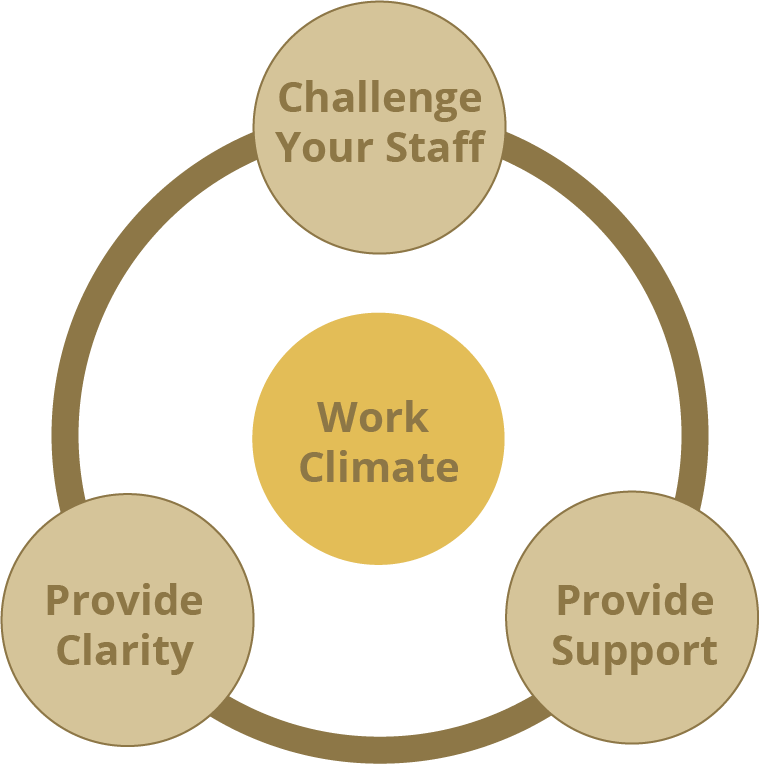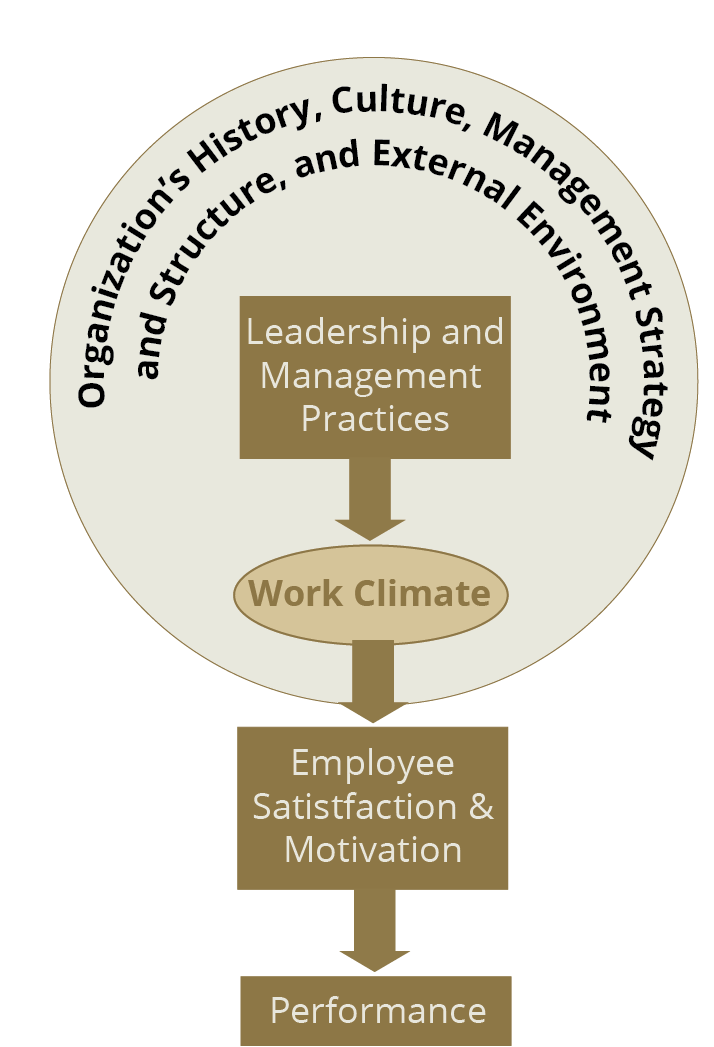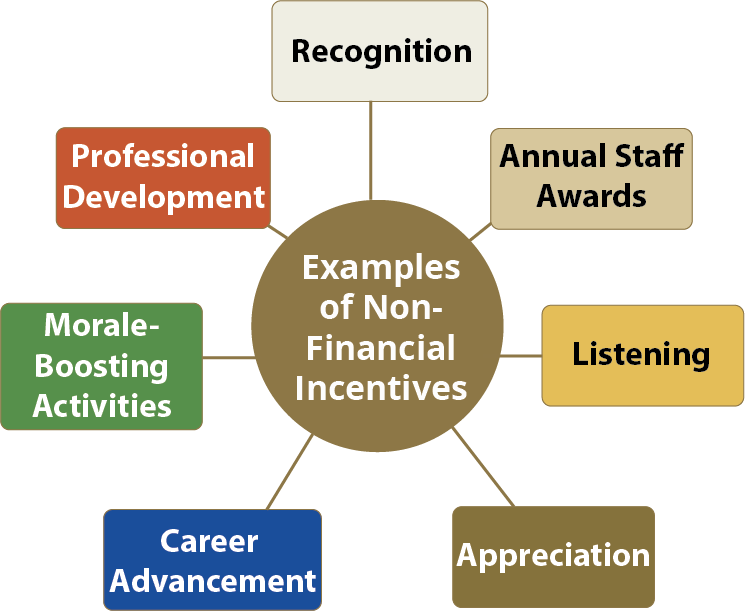Unit 11: Work Climate
In this unit, you will learn about how work climate affects employee performance and retention. You will learn about the factors that influence work climate, the dimensions of work climate, and the role of managers in creating a positive work climate. You will also learn about motivation and incentives, and how non-financial incentives can increase employee motivation.
Learning Objectives
Upon completion of this unit, you will be able to:
- Describe how a work climate impacts performance and retention;
- Identify at least two ways to improve the work climate; and
- List at least two non-financial incentives you can integrate into the work setting.
Practice
We encourage you to have a paper journal and pen with you to complete written activities and self-reflection assignments. Alternatively, you may find it useful to use Microsoft Word to complete written activities and self-reflection assignments.
Learning Activities
-
Introduction to Work Climate (10 min)
As leaders and managers, you are under pressure to achieve results. How can we ensure that those we manage perform at their best? A positive work climate can have a significant impact on staff motivation, performance, retention, and creative and productive work. When staff feel motivated, they want to work harder and bring their full capability to the task. They are more likely to stay at the organization, contribute positively and go “above and beyond” their normal duties. Positive workplaces allow employees to exceed expectations, often creating innovative ideas and producing better results.
So what is work climate exactly? According to Management Sciences for Health, work climate is “...the prevailing workplace atmosphere as experienced by employees. It is what it feels like to work in a group. “
Another way of looking at work climate is: “The unique climate of an organization creates a distinct atmosphere that is felt by the people who are part of the group. Climate can be thought of as the 'personality' of the organization.” —Adapted from education-portal.com
Take a moment to reflect on the work climate at your organization. What does it feel like to work in your office or unit? How do you think this affects staff in the work place?
-
Video: Everyday Leadership Profile – Address Malata (15 min)
Let’s begin this unit by watching a profile video from the Everyday Leadership series with Address Malata (Malawi). Dr. Malata discusses her leadership journey and how she contributes to a positive work environment.
Instructions: Tap the video to play.
Credit: University of WashingtonAfter you watch the video, in your journal, write your response to the following questions, then tap the Compare Answer button to reveal additional information.
- What are the two styles of leadership that Dr. Malata incorporates into her work?
- What are some challenges she has experienced, and how has she chosen to deal with those?
- In what ways do you think Dr. Malata’s leadership style and manner carry over to her colleagues and work environment?
Dr. Malata talks about distractions such as a lack of respect from other people at meetings. She believes it is important to ignore the distractions and not be derailed by them from your work. Dr. Malata is dedicated to being prepared and, therefore, creates a higher level of organization in her office. She believes in having an open door and that this is good for morale and solving small problems before they become large. She models service to others, and she believes in leadership at all levels. All of these contribute to creating a good work climate. -
Activity: Three Dimensions of Work Climate (15 min)
So what does a positive work climate look like? A positive work climate is one where employees feel they have the opportunity to grow, are clear about their roles and responsibilities, and feel appreciated for their work. These three dimensions of work climate (challenge, clarity and support) are critical for fostering performance. Each manager must find the right balance for their group’s climate.
Instructions: Tap each element on the diagram to reveal additional information about the three dimensions of work climate.

Challenge Your Staff
One of the dimensions of work climate is to challenge your staff. You can challenge your staff by offering opportunities for them to stretch and grow, supporting them to tackle challenges with reasonable risks, and helping them discover new ways of doing things to be more effective.
What types of actions can a manager take to challenge employees?
Provide Clarity
Another dimension of work climate is providing clarity. As a manager your task is to ensure that those you manage are clear about their roles and responsibilities. This clarity should be more specific than a job description. Along with this, you should help staff see how all roles contribute to the desired results of their group and organization.
Can you think of actions a manager can take to provide clarity?
Provide Support
Another dimension of work climate is providing support. A climate of support is created when group members feel their capabilities are acknowledged, when they participate in decisions that impact the work group, and when they sense appreciation and reward for both individual and group successes.
What types of actions can a manager take to challenge employees?
-
Reading: Creating a Work Climate That Motivates Staff and Improves Performance (60 min)
Read the following article from Management Sciences for Health and take a short assessment to help improve your work group’s climate. The assessment starts on page 10. Please have your journal by you to complete the assessment.
Click here to open a PDF version of the reading. This PDF will open in a new screen. Click here to open a PDF version of the reading. This PDF will open in a new screen. -
Reading: Role of the Manager in Influencing Work Climate (15 min)
Research suggests that leaders have a large role in impacting their work climate through their leadership and management practices, which you learned about in Unit 1. When leaders provide vision, recognize the contributions of staff, focus staff and align work with their interests, the work environment improves significantly.
Not all of the factors that affect an organization’s climate, however, are within the control of a manager or leader. It’s important as a leader or manager to recognize the aspects of your work climate you have little influence over and focus your energy on areas that you can impact.

Factors a Manager Can Control
Leadership Practices:
- Providing vision, living organizational values;
- Knowing staff aspirations, skills, and interests;
- Focusing staff attention on critical challenges;
- Aligning work with skills and interests, motivating teamwork; and
- Recognising accomplishments and inspiring confidence in staff.
Management Practices:
- Work group communications, inclusion in decision-making where appropriate;
- Revisions of job descriptions;
- Improvements in planning, policies, procedures, work planning;
- Supervision and feedback, including performance reviews, and job recommendations; and
- The organization’s management systems or procedures and processes that affect both tasks and the flow of information, and the work systems that affect efficiency and employee satisfaction.
Factors Beyond the Control of Most Managers:
Organizational History:
- Organizational experience with success and failure;
- Its experience with incentives, sanctions and consequences; and
- Its reputation in the community.
Organizational Culture:
- Values, beliefs, traditions, and assumptions shared by employees, whether expressed or unexpressed; and
- “The way we do things around here.”
Management Strategy:
- Approaches related to job opportunities and growth that help an organization meet its goals.
Management Structure:
- Defining roles and responsibilities; and
- Addressing policies regarding rewards and promotions.
External Environment:
- The broader context in which the organization operates. Prevailing disease patterns, political and economic conditions, regulations, processes of health sector reform, donor priorities, competition, and an organization’s reputation in the community add pressures on staff to perform.
- Available workforce skills, salary expectations, cultural and gender barriers, and the conditions of roads and public transportation. These may restrict the pool of potential employees, possibly requiring a stronger focus on developing and retaining staff.
- Reading: Motivation (10 min)
As a manager, you need to create conditions that will encourage employees to perform. Motivation is critical to employee performance. Motivation can be considered as simply as the energy to do something. It can also be defined as “the internal and external factors that stimulate desire and energy in people to be interested in a job, role, or subject, and exert effort in attaining a goal.” Each person has motives, needs and reservoirs of energy that represent potential motivators. As a manager, your task is to discover your employees’ motivations and help unleash their energy. When motivation is high, we perform better. When motivation is low, performance suffers.
There are two main types of motivation: internal and external.
External motivation involves using motivators that come with a job; for example, pay benefits, office space, and safety. A dangerous worksite or pay at survival level demotivates many employees. External motivation can also include giving positive feedback and recognition, often constructive motivators.
Internal motivation comes from within an employee. It can be influenced by the feeling that a supervisor cares about her or him as a person and opportunities for growth, advancement, recognition and responsibility. Think back for a moment to your own experiences as a member of a high-performing team. What were some of your internal motivators? Were they related to the satisfaction of innovating and creating a new approach, solving problems, making a contribution, surpassing established standards and goals, or learning and working with a dynamic group of people? Everyone has many of the same internal motivators, but individuals may be more inspired by different motivators. Do you know what motivates each member of your work group? Once you get to know your staff members and what motivates each of them, you can create a work climate that offers opportunities that will motivate them and encourage their performance.
Take a moment to reflect and write in your journal about what motivates you to perform. After this reflection, write down what you think motivates some of your staff or co-workers to perform.
Source: Management Sciences for Health. Creating a Work Climate That Motivates Staff and Improves Performance. Volume 11 Number 3. 2002
- Video: Showing You Care (2 min)
You just learned about the two types of motivation: internal and external. Watch this short Everyday Leadership video with Dr. Sam Phiri (Malawi) as he discusses the importance of showing people that you care about them.
Instructions: Tap the video to play.
Credit: University of WashingtonAfter you watch the video, in your journal, write your response to the following questions:
- What type of motivation does showing you care provide your employees?
- Has genuine care from a supervisor ever impacted your performance? If so, how?
- Video: Believing in Those Around You (2 min)
Providing opportunities for growth and recognizing your staff’s efforts can also be powerful internal motivators. Watch this short Everyday Leadership video with Ms. Magdalene Jeyarathnam (India) about the importance of believing in those around you.
Instructions: Tap the video to play.
Credit: University of Washington- Activity: Non-Financial Incentives (15 min)
You can use incentives to help motivate your staff to perform. You will have to consider the best mix of financial and non-financial incentives for your work group. Since it is often difficult to provide financial incentives, managers should think carefully and creatively about non-financial incentives they may be able to provide. It may come as a surprise that for problems related to the work environment, non-financial incentives are often more effective than financial ones.
Instructions: Tap each type of non-financial incentive to learn more.

Recognition
Recognize input, contributions, and hard work of employees.
Listening
Listen to staff ideas, concerns, and suggestions for change. Listening to your staff goes a long way in improving your work climate.
Appreciation
Praise the efforts and accomplishments of your staff on a regular basis.
Morale-boosting Activities
Organize morale-boosting activities for employees such as celebrations for milestones, holidays, etc.
Opportunities for Professional Development
Encourage professional development by allowing time for participating in a journal club, time for learning a new skill, or an opportunity to participate in a seminar, course, or other learning activity.
Career Advancement
Provide career advancement opportunities such as promotions and title changes.
Annual Staff Awards
Create staff awards for demonstrating problem-solving, leadership, creativity, teamwork, service, etc. These can be voted on by peers, awarded by a committee, or awarded by managers.
- Video: Acknowledgements (2 min)
As discussed earlier in the unit, recognition and appreciation are important non-financial incentives. Watch this short Everyday Leadership video with Jack Jourden (USA) as Mr. Jourden discusses the power of acknowledging others’ contributions.
Instructions: Tap the video to play.
Credit: University of Washington- Optional: Group Discussion (15 min)
If you are taking this course with a partner or in a group setting, have a conversation about your leadership and management experience by discussing the following questions:
- In your career, have you ever been a member of a high-performing team in an organization? What motivated you and your colleagues to perform well?
- If you have you ever been a member of an unmotivated team or organization, what held you back?
- Quiz: Unit Knowledge Check (15 min)
Assess your knowledge about the concepts you learned on work climate by answering four questions.
Instructions: Tap the correct answer, then tap the Feedback button to reveal the correct answers and additional information.
- Case Study: Work Climate (15 min)
Instructions: Think about the information that was shared with you on work climate so far to complete a short case study. Read the case scenario below, then respond to four questions about the case scenario. Please have your journal available to write your responses to the essay questions.
Case Study: You are an Admiral in the Navy and have been awarded command of an aircraft carrier. It has been reported that the previous Admiral was a very capable sailor, but was extremely harsh with assistant commanders and carrier crew. He communicated only with certain commanding staff. He would not listen to crew suggestions and would not address complaints. During unit briefings, he would constantly interrupt briefers, quote a regulation, and move on to the next topic. His orders were direct, rigid, and inflexible. Many of the men and women on board were not promoted, even though they were eligible, and the morale on the ship was at an all-time low. The crew and staff were very competent, hardworking, and dedicated to the Navy’s mission. The aircraft carrier unit had been recognized twice for outstanding performance on multinational operations by the Secretary of the Navy. A copy of the letter was posted outside the Captain’s bridge, but no personal recognition had ever been given to the crew.
1. Using the 3 Dimensions of Work Climate how can you, in your new leadership role: Challenge your crew? Provide Clarity to them? Provide Support to them? Write a response in your journal, then tap the Compare Answer button to read feedback.
Compare your response with the following:
- Challenge: You could challenge assistant commanders and crew to devise new procedures to improve ship operations and individual work stations for better efficiency.
- Clarity: You could review each job description with crew members and clearly define their roles and responsibilities. Any command order that is not clear could be immediately addressed.
- Support: You could confirm that everyone, at all levels, has total support by acknowledging individual capabilities and providing resources to achieve goals. Another way to support a positive work climate could be by engaging crew in regular discussions, listening intently, and seeking proactive solutions.
These three dimensions are critical for improving crew performance and motivation. By being proactive and taking action to improve the work climate, you could make the group and individuals feel they have the necessary resources and support to achieve their goals.
Tip! The assessment tool shared in the Management Sciences for Health reading may help to improve the climate of the team.
3. How can improving aircraft carrier safety be used to show the crew you care for them? Write a response in your journal, then tap the Compare Answer button to read feedback.
FeedbackCompare your response with the following ideas: Issue a directive to all crew members that their safety and the safety of their work station are top priorities. Let them know that if there are safety concerns, any individual can elevate them to the Commander. By placing safety as a top priority, you demonstrate there is a genuine concern for the safety of each individual. You demonstrate caring by allowing any safety issue to go directly to the Commander. “Safety” is an external motivator and “Caring” is an internal motivator.
- Self-Reflection: Learning Action Plan (15 min)
Putting your learning into action is essential to knowledge transfer, applying the knowledge you gained in this unit, and retaining that information in the future.
Take a moment to reflect on what you’ve learned in this unit. After reflecting, in your journal, write:
- Four things you learned in the unit.
- Three things you will implement:
- Today;
- Six months from now; and
- One year from now.
- Two things that changed your perspective.
- One thing you will ask for more help with.
- Reading: Conclusion (5 min)
In this unit, you learned about how a positive work climate increases employee motivation and performance and improves staff retention. You learned about the three dimensions of work climate and how managers can influence work climate. Lastly, you learned about motivation and the role that non-financial incentives can play in improving employee motivation.